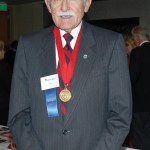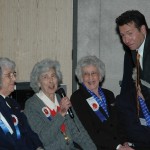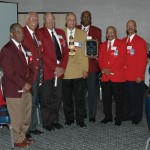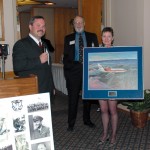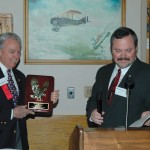
Nick Carter, 9NEWS meteorologist and master of ceremonies, and Bea Khan Wilhite, president of the Colorado Aviation Historical Society, get ready to begin the ceremony.
Two organizations were honored at the annual Colorado Aviation Historical Society’s Hall of Fame Banquet and Induction Ceremony, which took place November 6 at the U.S. Air Force Academy in Colorado Springs. The Women Airforce Service Pilots and the Red Tails Hubert L. “Hooks” Jones Chapter of Tuskegee Airmen Inc. were inducted into the Colorado Aviation Hall of Fame.
Congress passed the Civilian Pilot Training Act in 1939 to create a pool of trained aviators. Civilian schools provided the required training, but while black colleges participated, the Army maintained that since there were no black Army Air Corps units, there would be no unit to which to assign African-American graduates of training programs. That changed in January 1941 when the formation of an all-black pursuit squadron was finally announced.
The 99th Pursuit Squadron began training on July 19, 1941, through the Tuskegee Institute in eastern Alabama. The Tuskegee Airmen, which would eventually include the 99th, 100th, 301st and 302nd pursuit squadrons, of the 332nd Fighter Group, were trained at the Tuskegee Army Air Field. By the end of the war, more than 1,000 men had graduated from pilot training at Tuskegee; 450 were sent overseas for combat assignment. Additional men were trained at Tuskegee for aircrew and ground crew duties.
The Tuskegee Airmen flew more than 15,000 sorties, completed more than 1,500 missions, and destroyed over 250 enemy aircraft during WWII. They earned 850 medals for their bravery in combat. The performance of these airmen ushered in the desegregation of the military in 1947.
Today, Tuskegee Airmen Inc., a nonprofit organization, is dedicated to perpetuating the history of the African-Americans who participated in air crew, ground crew and operations support training in the Army Air Corps during WWII. The Denver-based Red Tails Hubert L. “Hooks” Jones Chapter of Tuskegee Airmen Inc. is one of the largest and most active in over 40 national chapters dedicated to making sure that the story of the Tuskegee Airmen is told. The organization isn’t happy to just make sure the past is known, however. It sponsors scholarships for young people interested in aviation, awarding approximately 45 a year. The Hubert L. “Hooks” Jones Chapter actively does its part by introducing youth to airborne activities through the Mile High Flight Program.
In August 1943, the Women’s Auxiliary Ferrying Squadron and the Women’s Flying Training Detachment were incorporated into the Women Airforce Service Pilots. With the primary mission of moving aircraft as needed to support the build-up of the Armed Forces, the WASP ferried combat aircraft from factories to modification centers, ports of embarkation, combat training fields, flying schools, artillery bases and to tow-target squadrons. Overall, 1,830 pilots were selected to train for the WASP, of which 1,074 graduated. Before being deactivated in December 1944, they would log more than 60 million miles, and ferry approximately 50 percent of all pursuit aircraft in the U.S. They would ferry 77 different types, including the P-40, P-47, P-51, C-47, C-46, B-17, A-25, A-26, B-25, and B-29.
- L to R: Millicent Young, Lucile Wise, Gayle Snell, Annabelle Moss, Kathryn Gunderson, Betty Pfister, Betty Jo Reed, Doris Tracy and Marion Trick (seated) were on hand to be honored for the many accomplishments of the Women Airforce Service Pilots.
- Harry Blout was inducted into the CAHF in 1993.
- Nick Carter listens as Betty Pfister talks about her experiences as a WASP.
- L to R: Tuskegee Airmen Col. Fitzroy “Buck” Newsum, Samuel C. Hunter Jr., Lowell Bell, Loran Smith and John H. Smith pose with Gilbert Wheeler, board member, Hubert L.
- CAHF enshrinee and Copter 4 pilot Mike Silva, with wife Susie.
- Airport Journals Editor Di Freeze visits with CAHF enshrinees Gen. Steve Ritchie (left) and Col. Jack Wilhite.
- R to L: Chris Lucas, FAA awards chairperson and safety counselor, and Alan C. Davis, safety counselor, surprised Brian Richardson, Denver Flight Standards District Office safety program manager, with a Rick Broome print, donated by the artist.
- R to L: Brian Richardson, Denver FSDO safety program manager, presented Peter Paul Luce with the Golden Eagles award.
- L to R: Jay Warner, CAHF enshrinees Emily Howell Warner and Rick Broome, and Betty Jo Reed.













